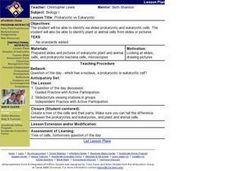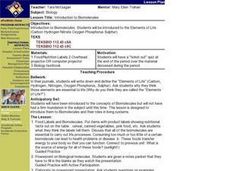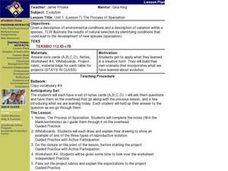Curated OER
Photosynthesis: Light-dependent and Calvin cycle
Students recognize the concepts of the light-dependent and the Calvin cycles. They draw diagrams of the light-dependent reaction and the Calvin cycle. In addition, they investigate the effects of light on carbohydrate content in leaves.
Curated OER
Safety in the Biology laboratory
Students review safety in the biology laboratory. They summarize the rules and safety procedures by completing several activities such as practice questions, taking notes andbecoming familiar with the location of safety equipment.
Curated OER
Diversity of Protists
Students identify under a microscope several different genera of protists. They discuss the three different categories of protists. Students discuss characteristics of the protists that they have already been taught. They view and...
Curated OER
TAKS Biology Review
Students review some TAKS objectives in life science preparing for the upcoming TAKS test. They are given their TAKS review workbook, students look at objectives 1 and 2 in the workbook. Students review and ask questions about the...
Curated OER
Natural Selection
Young scholars comprehend that natural selectionis the tool for adaptation and evolution of populations. They pick three M&M's and no candy corns. Students tally the number of different color M&M's chosen. They discuss why...
Curated OER
Geologic Time Scale
Students recreate and comprehend the geologic time scale. They discuss how long humans have been around on Earth. Students are shown the geologic time scale and its different parts. They work in groups to recreate the time scale.
Curated OER
Structure of the Atom
Students identify the location and change of the subatomic particles of an atom. They name the three subatomic particles. Students review what they can recall about subatomic particles. They are given a worksheet on the subatomic...
Curated OER
Prokaryotic vs Eukaryotic
Students identify via slides prokaryotic and eukaryotic cells. They identify plant or animal cells from slides or pictures. Students are given the question of the day. They are asked which has a nucleus, a prokaryotic or eukaryotic...
Curated OER
Identifying Biomes
Students compare the differences between the different terrestrial and aquatic biomes. They discuss the characteristics of each biome. Students are asked what biome they live in. They are asked what is the biome located on land called?...
Curated OER
Phases of Matter
Students comprehend the different phases of matter. They give examples of each phase and describe the processes of changing between these phases. Students are asked what is plasma? They are asked what is the four phases of matter? ...
Curated OER
Frogguts
Pupils comprehend the basic anatomy of the frog and prepare themselves for dissection. They work through the virtual dissection. Students complete the worksheet and begin to assemble the frog skeleton. They are assigned frog...
Curated OER
Discoveries in Genetics
Students review the basic concepts of DNA. They view a video, Bill Nye " A Discovery in Genetics." Students are told that the answers to the worksheet are on the video. They complete the worksheet and turn it in at the end of class.
Curated OER
Protists: animallike Protists
Students are taught that Malaria and African Sleeping sickness are caused by protists. They discuss how animal-like protists harm other living things. Students discuss and listen to the major phyla of animallike protists. They draw...
Curated OER
Icecream in a Baggie
Students apply their comprehension of colligative properties to real-world situations. They review the concepts of physical and chemical changes. Students are reminded that science is used extensively in food-production. They are...
Curated OER
Introduction to Biomolecules
Students are introduced to biomolecules and their roles in livin systems. They are introduced to the "Elements of Life." Students write down and define the "Elements of Life." They are asked why they think those elements are essential...
Curated OER
The Process of Speciation
Students illustrate the results of natural selection by identifying conditions that could lead to the development of new species (speciation) based on a given description of environmental conditions and description of variation within a...
Curated OER
History of Theory of Evolution
Students infer evolutionary relationships by comparing the physiological data or description. They write what they think would happen if a brown bear in the woods had an offspring that was white. Would this help the baby bear in its...
Curated OER
Periodic Table
Students identify in what groups and periods element is, state how many valance electrons element has, list basic properties of groups on periodic table, fill electrons in correct energy level/groups, and answer chapter questions.
Curated OER
IPC Review
Students discuss the difference between atoms and elements. They analyze how compounds are formed. Students discuss the difference between covalent bonds, hydrogen bonds, and ionic bonds. They review bonding with diagrams, "Atoms or...
Curated OER
Energy in Living Systems
Students are asked: Is our life's purpose over when it's over? What happens to our bodies? They analyze the flow of energy through living systems. Students compare the metabolism of autotrophs with that of heterotrophs. They create a...
Curated OER
Photosynthesis Review
Students review the objectives for the light and dark reactions on photosynthesis. They discuss the conversion of Carbon dioxide to simple sugars occurs in the light independent reactions. Students are given the question of the day. ...
Curated OER
Writing Is Rough
Students identify the main idea in a story and discuss their own writing. They examine the sources of conflict in the story or the piece they are writing. They make portfolios of their best writing samples.
Curated OER
Plants
Sixth graders examine how plants collect water and breathe. In groups, they participate in a variety of activities in which they discover how plants operate in terrariums. To end the lesson, they discuss why plants are important to the...
Curated OER
Science Unit Lesson Five
Sixth graders review how and which plants operate in terrariums. In groups, they follow instructions to make their own terrarium and place different types of plants in it. To end the lesson, they review the steps in the water cycle and...























